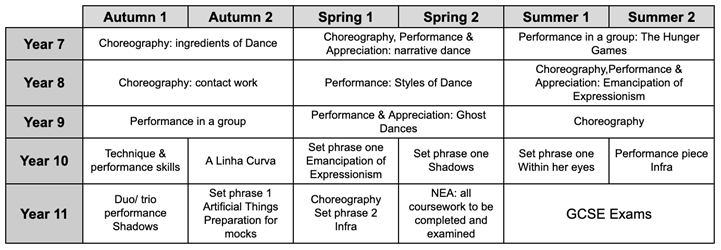DANCE
Curriculum Purpose
Teaching Dance for its intrinsic value
Dance is a unique and joyful subject to study; it allows students to explore and develop their creative, physical, emotional and intellectual capacities as one.
The curriculum at Trinity is designed so that students gain knowledge within all these areas and build self confidence to experience the thrill of moving & performing.
We are all dancers
All humans move: dance is structured movement. Our curriculum will equip our students with the knowledge (tacit, procedural, declarative) within the core content of Dance: choreography, performance and critical appreciation.
The needs of our community
We will expose pupils to dance that builds and broadens their cultural capital including a wide range of professional works, modelling and performance opportunities.
Preparing for academic success
We will provide students with a solid knowledge base of choreography and performing enabling them to continue the academic study of dance into GCSE, A Level and beyond.
Curriculum Rationale
What is taught and why?
Dance is a subject that gives students the opportunity to develop their creative, imaginative, physical, emotional and intellectual capacities. Students do this by focusing on three areas: Choreography, performance and critical appreciation of dance.
Choreography is the skill of combining movements into phrases and/or dances to be performed. Students study and experience the key elements that make up choreography: the actions, dynamics, space and relationships of the dancers in relation to a theme or dance idea. It allows students to articulate themselves in a nonverbal way, access creative parts of the brain and develop soft skills including leadership and team work.
We teach students performance knowledge so they experience the joy of performing. These are divided into a series of skills: physical, technical, expressive and mental skills. All students are expected to perform in a class situation and are given the opportunity to perform within and beyond the school.
Critical appreciation of dance is the ability to describe and evaluate dance. This includes their own work, the work of others and professional dance works. Students learn how to gain this knowledge through oracy and written work which increases in difficulty across the year groups.
Why is it taught in that sequence?
Each core content is taught within every scheme of work, although our termly assessments have a focus upon just one of them.
As students progress through the school, the knowledge they are required to learn increases in intensity and difficulty. For example a taught phrase in Year 7 will be shorter and contain movements that are simpler than a phrase taught in Year 10 – the speed, use of levels, action content and coordination requirements are a small example of what may be different.
A choreography task in Year 9 will be more open and less directed than one in Year 8 as the students have prior knowledge of, for example, formations within the dance space.
Curriculum Overview

